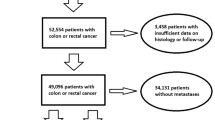Abstract
The clinical characteristics of 152 patients diagnosed with two primary metachronous tumors—one or both of them in the colon—were studied. Nineteen patients had both primary tumors in the colon (Group I), 59 had the first primary tumor in the colon and the second tumor elsewhere (Group II), and 74 had the second primary tumor in the colon and the first primary tumor elsewhere (Group III). The group in which the second primary tumor was in the colon included significantly more female patients than did the other two groups, with a younger median age at diagnosis of first tumor. The median time interval between the two primary tumors was 44, 57, and 62 months in Groups I, II, and III, respectively. The number of clinic visits during the year before diagnosis of the second primary was similar in all groups, but only 60 percent of the patients kept their follow-up appointment. In most instances, the diagnosis was made after the patients' symptoms, although only a small percentage of the second primary tumors (15–30 percent) were diagnosed during routine follow-up. The second primary tumor occurred in the field of radiotherapy of the first primary tumor in 27 of 35 patients who received radiotherapy. To increase the number of patients diagnosed in an earlier stage of disease, they should be urged to keep their follow-up appointment, and physicians following patients with single tumors should be aware of the increased likelihood of a second tumor. To increase the cure rate of those tumors, efforts toward early diagnosis are warranted. This includes physical examination and mammography to detect breast cancer in women, annual occult blood tests and rectal examination, and sigmoidoscopy or colonoscopy at three-year intervals to detect colon cancer early
Similar content being viewed by others
References
National Institutes of Health. Annual Cancer Statistics Review Including Cancer Trends, 1950–1985. Bethesda, MD: publication 88-2789. February 1988.
Cohen AM, Shank B, Friedman MA. In: De Vita VT, Hellman S, Rosenberg SA, eds. Cancer principles and practice of oncology. Philadelphia: JB Lippincott, 1989:895–952.
Curtis RE, Boice JD, Kleinerman RA, Flannery JT, Fraumeni JF. Summary: multiple primary cancers in Connecticut 1935–82. NCI Monogr 1985;68:219–42.
Bulow S, Svendson LB, Mellengaard A. Metachronous colorectal carcinoma. Br J Surg 1990;77:502–7.
Okamoto N, Morio S, Inoue R, Akiyama K. The risk of a second primary cancer occurring in five year survivors of initial cancer. Jpn J Clin Oncol 1987;17:205–13.
Enblad P, Adami HD, Glimeluis B, Krusemo U, Pahlman L. The risk of subsequent primary malignant disease after cancer of the colon and rectum. Cancer 1990;65:2091–100.
Schatzkin A, Baranovsky A, Kessler LG. Diet and cancer: evidence from associations of multiple primary cancers in the SEER program. Cancer 1988;62:1451–7.
Neugut AI, Murray TI, Lee WC, Robinson E. The association of breast cancer and colorectal cancer in men: an analysis of SEER program data. Cancer 1991;68:2069–73.
Agarwal N, Ulahannan MJ, Mandile MA, Cayten CG, Pitchumoni CS. Increased risk of colorectal cancer following breast cancer. Ann Surg 1986;203:307–10.
Hoar SH, Wilson J, Blot J, McLaughlin JK, Winn DM, Kantor AF. Second cancer following cancer of the digestive system in Connecticut 1935–82. NCI Monogr 1985;68:49–82.
Rozen P, Fireman Z, Figer A, Ron E. Colorectal tumor screening in women with a past history of breast, uterine or ovarian malignancies. Cancer 1986;57:1235–9.
Israel Cancer Registry. Cancer in Israel—facts and figures 1977–1981. State of Israel, Ministry of Health, December 1987, Jerusalem.
St. John DJ, McDermott FT, Katriwessis H, Debney EA. Cancer risk for relatives of patients with sporadic colorectal cancer. Second International Conference on Gastrointestinal Cancer. August 1989:43.
Gatzen C, Vipond MN, Fish DE, Snell ME. Three new primary pelvic carcinomas in a patient following radiotherapy for carcinoma of the cervix. Acta Chir Scand 1990;156:183–6.
Hay JH, Duncan W, Kerr GR. Subsequent malignancies in patients irradiated for testicular tumors. Br J Radiol 1984;57:597–602.
Robinson E, Mohilever J, Zidan J, Sapir D. Colorectal cancer incidence, delay in diagnosis and stage of disease. Eur J Cancer Clin Oncol 1986;22:157–61.
Eddy DM. Guidelines for the cancer-related checkup: recommendations and rationale. CA 1980;30:193–240.
Author information
Authors and Affiliations
About this article
Cite this article
Robinson, E., Nasrallah, S., Adler, Z. et al. Clinical, demographic, and follow-up characteristics of patients with two primary metachronous tumors, one of them being in the colon. Dis Colon Rectum 35, 457–461 (1992). https://doi.org/10.1007/BF02049402
Issue Date:
DOI: https://doi.org/10.1007/BF02049402




